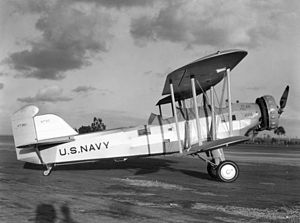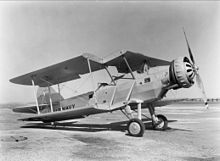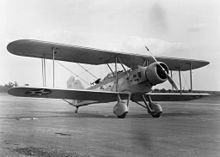- Douglas XT3D
-
Douglas XT3D Douglas XT3D-1 Role Three-seat torpedo bomber National origin United States Manufacturer Douglas Aircraft Company First flight 1931 Retired 1941 Primary user United States Navy Number built 1 The Douglas XT3D was an American three-seat torpedo bomber biplane developed by the Douglas Aircraft Company to meet a United States Navy requirement.[1]
Development
The XT3D torpedo bomber (BuNo 8730) was first flown in 1931, it has been described as a large and ugly aircraft.[1] Of metal construction with a fabric covering the XT3D had folding wings and an arrestor hook for carrier operation.[1] With a fixed tailwheel landing gear and powered by a Pratt & Whitney S2B1-G Hornet radial engine.[1] The XT3D had three open cockpits, forward for the gunner/bomb-aimer, centre for the pilot and a rear cockpit for another gunner.[1]
The XT3D failed to meet the naval requirements and after tests was returned to Douglas.[1] It was modified with bigger engine, a Pratt & Whitney XR-1830-54 radial, wheel fairings and the two rear cockpits were enclosed.[1] Re-designated the XT3D-2 it still failed to pass navy test and was not ordered into production.[1] The prototype was used by the Navy for the next ten years for general purpose use until it was relegated as an instructional airframe in 1941.[1]
Variants
- XT3D-1
- Prototype powered by a Pratt & Whitney S2B1-G Hornet radial engine, one built.[1][2]
- XT3D-2
- Prototype modifed including a change to a Pratt & Whitney XR-1830-54 radial engine.[1][2]
Operators
Sepcifications
Data from [1]
General characteristics
- Crew: 3 (pilot, bomb-aimer/gunner, gunner
- Length: 35 ft 5 in (10.80 m)
- Wingspan: 50 ft 0 in (15.24 m)
- Height: 13 ft 2.5 in (4.026 m)
- Wing area: 624 sq ft (58.0 m2)
- Empty weight: 4,238 lb (1,922 kg)
- Max takeoff weight: 7,857 lb (3,564 kg)
- Powerplant: 1 × Pratt & Whitney S2B1-G Hornet radial piston engine, 575 hp (429 kW)
Performance
- Maximum speed: 128 mph (206 km/h; 111 kn) at 6000ft (1830m)
- Range: 555 mi (482 nmi; 893 km)
- Service ceiling: 14,000 ft (4,267 m)
Armament
- Guns: 2 × 0.3in (7.62mm) machine-gun (flexible mounted on forward and rear cockpits)
- Bombs: 1835lb (832kG) torpedo or equivalent in bombs
See also
- Related lists
References
Notes
Bibliography
- Andrade, John (1979). U.S.Military Aircraft Designations and Serials since 1909. Midland Counties Publications. ISBN 0-904597-22-9.
- The Illustrated Encyclopedia of Aircraft (Part Work 1982-1985). Orbis Publishing.
Douglas military aircraft Fighters Ground attack Naval bombers
and attack aircraftBombers Observation Patrol PD · P2D · P3D
Reconnaisance Transports C-1 · C-21 · C-32 · C-33 · YC-34 · C-38 · C-39 · C-41 · C-41A · C-42 · C-47 · C-48 · C-49 · C-50 · C-51 · C-52 · C-53 · C-54 · C-58 · UC-67 · C-68 · C-74 · C-84 · C-110 · XC-112/YC-112 · XC-114 · YC-116 · C-117 · C-118 · C-124 · YC-129 · C-133 · XCG-17
C-9 · C-24
RD · R2D · R3D · R4D (R4D-2 & R4D-4) · R5D · JD · R6D
CC-129 · Dakota I/III/IV · Dakota II · LXD1 · PD.808 · Skymaster ITraining aircraft Experimental USN/USMC torpedo aircraft designations pre-1962 Torpedo CTTEFTGreat LakesStoutSTTorpedo Bomber Great LakesTBGTBVPatrol Torpedo Bomber HallTorpedo Scout Lists relating to aviation General Aircraft (manufacturers) · Aircraft engines (manufacturers) · Airlines (defunct) · Airports · Civil authorities · Museums · Registration prefixes · Rotorcraft (manufacturers) · TimelineMilitary Accidents/incidents Records Categories:- Douglas aircraft
- Torpedo bombers
- United States bomber aircraft 1930–1939
Wikimedia Foundation. 2010.



